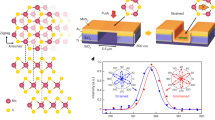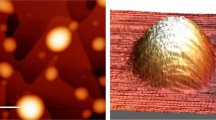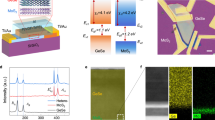Abstract
The theoretical Shockley–Queisser limit of photon–electricity conversion in a conventional p–n junction could be potentially overcome by the bulk photovoltaic effect that uniquely occurs in non-centrosymmetric materials. Using strain-gradient engineering, the flexo-photovoltaic effect, that is, the strain-gradient-induced bulk photovoltaic effect, can be activated in centrosymmetric semiconductors, considerably expanding material choices for future sensing and energy applications. Here we report an experimental demonstration of the flexo-photovoltaic effect in an archetypal two-dimensional material, MoS2, by using a strain-gradient engineering approach based on the structural inhomogeneity and phase transition of a hybrid system consisting of MoS2 and VO2. The experimental bulk photovoltaic coefficient in MoS2 is orders of magnitude higher than that in most non-centrosymmetric materials. Our findings unveil the fundamental relation between the flexo-photovoltaic effect and a strain gradient in low-dimensional materials, which could potentially inspire the exploration of new optoelectronic phenomena in strain-gradient-engineered materials.
This is a preview of subscription content, access via your institution
Access options
Access Nature and 54 other Nature Portfolio journals
Get Nature+, our best-value online-access subscription
$29.99 / 30 days
cancel any time
Subscribe to this journal
Receive 12 print issues and online access
$259.00 per year
only $21.58 per issue
Buy this article
- Purchase on Springer Link
- Instant access to full article PDF
Prices may be subject to local taxes which are calculated during checkout




Similar content being viewed by others
Data availability
The data of this study are available from the corresponding author upon reasonable request.
References
Sturman, B. I. & Fridkin, V. M. Photovoltaic and Photo-Refractive Effects in Noncentrosymmetric Materials Vol. 8 (CRC, 1992).
Glass, A. M., Linde, D. V. D. & Negran, T. J. High-voltage bulk photovoltaic effect and the photorefractive process in LiNbO3. Appl. Phys. Lett. 25, 233–235 (1974).
Koch, W. T. H., Munser, R., Ruppel, W. & Würfel, P. Bulk photovoltaic effect in BaTiO3. Solid State Commun. 17, 847–850 (1975).
Brody, P. S. High voltage photovoltaic effect in barium titanate and lead titanate-lead zirconate ceramics. J. Solid State Chem. 12, 193–200 (1975).
Nadupalli, S., Kreisel, J. & Granzow, T. Increasing bulk photovoltaic current by strain tuning. Sci. Adv. 5, eaau9199 (2019).
Qin, M., Yao, K. & Liang, Y. C. High efficient photovoltaics in nanoscaled ferroelectric thin films. Appl. Phys. Lett. 93, 122904 (2008).
Choi, T., Lee, S., Choi, Y. J., Kiryukhin, V. & Cheong, S.-W. Switchable ferroelectric diode and photovoltaic effect in BiFeO3. Science 324, 63–66 (2009).
Alexe, M. & Hesse, D. Tip-enhanced photovoltaic effects in bismuth ferrite. Nat. Commun. 2, 256 (2011).
Zenkevich, A. et al. Giant bulk photovoltaic effect in thin ferroelectric BaTiO3 films. Phys. Rev. B 90, 161409 (2014).
Spanier, J. E. et al. Power conversion efficiency exceeding the Shockley–Queisser limit in a ferroelectric insulator. Nat. Photonics 10, 611–616 (2016).
Nechache, R. et al. Photovoltaic properties of Bi2FeCrO6 epitaxial thin films. Appl. Phys. Lett. 98, 202902 (2011).
Grinberg, I. et al. Perovskite oxides for visible-light-absorbing ferroelectric and photovoltaic materials. Nature 503, 509–512 (2013).
Sun, Z. et al. A photoferroelectric perovskite-type organometallic halide with exceptional anisotropy of bulk photovoltaic effects. Angew. Chem. Int. Ed. 55, 6545–6550 (2016).
Nakamura, M. et al. Shift current photovoltaic effect in a ferroelectric charge-transfer complex. Nat. Commun. 8, 281 (2017).
Osterhoudt, G. B. et al. Colossal mid-infrared bulk photovoltaic effect in a type-I Weyl semimetal. Nat. Mater. 18, 471–475 (2019).
Zhang, Y. J. et al. Enhanced intrinsic photovoltaic effect in tungsten disulfide nanotubes. Nature 570, 349–353 (2019).
Belinicher, V., Ivchenko, E. & Sturman, B. Kinetic theory of the displacement photovoltaic effect in piezoelectrics. Zh. Eksp. Teor. Fiz. 83, 649–661 (1982).
Yang, M.-M., Kim, D. J. & Alexe, M. Flexo-photovoltaic effect. Science 360, 904–907 (2018).
Mashkevich, V. & Tolpygo, K. Electrical, optical and elastic properties of diamond type crystals. Sov. Phys. JETP 5, 435–439 (1957).
Kogan, S. M. Piezoelectric effect during inhomogeneous deformation and acoustic scattering of carriers in crystals. Sov. Phys. Solid State 5, 2069–2070 (1964).
Hong, J. & Vanderbilt, D. First-principles theory of frozen-ion flexoelectricity. Phys. Rev. B 84, 180101 (2011).
Wang, B., Gu, Y., Zhang, S. & Chen, L.-Q. Flexoelectricity in solids: progress, challenges, and perspectives. Prog. Mater. Sci. 106, 100570 (2019).
Cross, L. E. Flexoelectric effects: charge separation in insulating solids subjected to elastic strain gradients. J. Mater. Sci. 41, 53–63 (2006).
Chu, K. et al. Enhancement of the anisotropic photocurrent in ferroelectric oxides by strain gradients. Nat. Nanotechnol. 10, 972–979 (2015).
Gao, P. et al. Atomic-scale measurement of flexoelectric polarization at SrTiO3 dislocations. Phys. Rev. Lett. 120, 267601 (2018).
Wang, H. et al. Direct observation of huge flexoelectric polarization around crack tips. Nano Lett. 20, 88–94 (2020).
Lee, D. et al. Giant flexoelectric effect in ferroelectric epitaxial thin films. Phys. Rev. Lett. 107, 057602 (2011).
Park, S. M. et al. Colossal flexoresistance in dielectrics. Nat. Commun. 11, 2586 (2020).
Guo, R. et al. Continuously controllable photoconductance in freestanding BiFeO3 by the macroscopic flexoelectric effect. Nat. Commun. 11, 2571 (2020).
Bertolazzi, S., Brivio, J. & Kis, A. Stretching and breaking of ultrathin MoS2. ACS Nano 5, 9703–9709 (2011).
Dumitrică, T., Landis, C. M. & Yakobson, B. I. Curvature-induced polarization in carbon nanoshells. Chem. Phys. Lett. 360, 182–188 (2002).
Duerloo, K.-A. N. & Reed, E. J. Flexural electromechanical coupling: a nanoscale emergent property of boron nitride bilayers. Nano Lett. 13, 1681–1686 (2013).
Shi, W., Guo, Y., Zhang, Z. & Guo, W. Flexoelectricity in monolayer transition metal dichalcogenides. J. Phys. Chem. Lett. 9, 6841–6846 (2018).
Feng, J., Qian, X. F., Huang, C. W. & Li, J. Strain-engineered artificial atom as a broad-spectrum solar energy funnel. Nat. Photonics 6, 865–871 (2012).
Schankler, A. M., Gao, L. & Rappe, A. M. Large bulk piezophotovoltaic effect of monolayer 2H-MoS2. J. Phys. Chem. Lett. 12, 1244–1249 (2021).
Li, H. et al. Optoelectronic crystal of artificial atoms in strain-textured molybdenum disulphide. Nat. Commun. 6, 7381 (2015).
Castellanos-Gomez, A. et al. Deterministic transfer of two-dimensional materials by all-dry viscoelastic stamping. 2D Mater. 1, 011002 (2014).
Rice, C. et al. Raman-scattering measurements and first-principles calculations of strain-induced phonon shifts in monolayer MoS2. Phys. Rev. B 87, 081307 (2013).
Chakraborty, B., Matte, H. S. S. R., Sood, A. K. & Rao, C. N. R. Layer-dependent resonant Raman scattering of a few layer MoS2. J. Raman Spectrosc. 44, 92–96 (2013).
Buscema, M. et al. Large and tunable photothermoelectric effect in single-layer MoS2. Nano Lett. 13, 358–363 (2013).
Sahoo, S., Gaur, A. P. S., Ahmadi, M., Guinel, M. J. F. & Katiyar, R. S. Temperature-dependent Raman studies and thermal conductivity of few-layer MoS2. J. Phys. Chem. C. 117, 9042–9047 (2013).
El-Mahalawy, S. H. & Evans, B. L. The thermal expansion of 2H-MoS2, 2H-MoSe2 and 2H-WSe2 between 20 and 800 °C. J. Appl. Crystallogr. 9, 403–406 (1976).
Lager, G. A., Jorgensen, J. D. & Rotella, F. J. Crystal structure and thermal expansion of α‐quartz SiO2 at low temperatures. J. Appl. Phys. 53, 6751–6756 (1982).
Cao, J. et al. Extended mapping and exploration of the vanadium dioxide stress-temperature phase diagram. Nano Lett. 10, 2667–2673 (2010).
Cui, X. et al. Multi-terminal transport measurements of MoS2 using a van der Waals heterostructure device platform. Nat. Nanotechnol. 10, 534–540 (2015).
Beal, A. R. & Hughes, H. P. Kramers-Kronig analysis of the reflectivity spectra of 2H-MoS2, 2H-MoSe2and 2H-MoTe2. J. Phys. C: Solid State Phys. 12, 881–890 (1979).
Ichiki, M. et al. Photovoltaic effect of lead lanthanum zirconate titanate in a layered film structure design. Appl. Phys. Lett. 84, 395–397 (2004).
Cao, D. et al. High-efficiency ferroelectric-film solar cells with an n-type Cu2O cathode buffer layer. Nano Lett. 12, 2803–2809 (2012).
Ji, W., Yao, K. & Liang, Y. C. Bulk photovoltaic effect at visible wavelength in epitaxial ferroelectric BiFeO3 thin films. Adv. Mater. 22, 1763–1766 (2010).
Yang, S. Y. et al. Above-bandgap voltages from ferroelectric photovoltaic devices. Nat. Nanotechnol. 5, 143–147 (2010).
Xiao, Z. et al. Giant switchable photovoltaic effect in organometal trihalide perovskite devices. Nat. Mater. 14, 193–198 (2015).
Zhang, G. et al. New high Tc multiferroics KBiFe2O5 with narrow band gap and promising photovoltaic effect. Sci. Rep. 3, 1265 (2013).
Astafiev, S., Fridkin, V. & Lazarev, V. The influence of the magnetic field on the linear bulk photovoltaic current in piezoelectric semiconductor GaP. Ferroelectrics 80, 251–254 (1988).
Fridkin, V. M., Grekov, A. A. & Rodin, A. I. The bulk photovoltaic effect in the crystals without a center of symmetry. Ferroelectrics 43, 99–108 (1982).
Mistewicz, K., Nowak, M. & Stróż, D. A ferroelectric–photovoltaic effect in SbSI nanowires. Nanomaterials 9, 580 (2019).
Burger, A. M. et al. Direct observation of shift and ballistic photovoltaic currents. Sci. Adv. 5, eaau5588 (2019).
Matsuo, H., Noguchi, Y. & Miyayama, M. Gap-state engineering of visible-light-active ferroelectrics for photovoltaic applications. Nat. Commun. 8, 207 (2017).
Laurenti, M. et al. Nanobranched ZnO structure: p-type doping induces piezoelectric voltage generation and ferroelectric–photovoltaic effect. Adv. Mater. 27, 4218–4223 (2015).
Chakrabartty, J., Harnagea, C., Celikin, M., Rosei, F. & Nechache, R. Improved photovoltaic performance from inorganic perovskite oxide thin films with mixed crystal phases. Nat. Photonics 12, 271–276 (2018).
You, L. et al. Enhancing ferroelectric photovoltaic effect by polar order engineering. Sci. Adv. 4, eaat3438 (2018).
Acknowledgements
This work is supported by the US Army Research Office under grant number W911NF-21-1-0013 (J.J. and J.S.) and Air Force Office of Scientific Research under grant number FA9550-18-1-0116 (Y.W. and J.S.). The work is also supported by the NYSTAR Focus Center at Rensselaer Polytechnic Institute with contract number C150117 (L.Z., Y.X., G.-C.W. and J.S.). This work is also partially supported by the National Science Foundation under award numbers 2024972, 2031692 and 1916652 (Y.H., Z.C. and J.S.).
Author information
Authors and Affiliations
Contributions
J.J. and J.S. conceived the idea and designed the experiments (device structure, temperature-dependent and photon-polarization-dependent measurements). J.J. built the 2D materials transfer system and assembled the SPCM setup. J.J. prepared samples and fabricated the devices. Y.W. assisted with the growth of VO2. J.J. performed Raman mappings, photocurrent mappings and light polarization dependence measurements. Z.C. and Y.H. assisted photocurrent measurements and calibrations. Y.X. and L.Z. performed atomic force microscopy measurements. J.J. processed the data. J.J. and J.S. analysed and interpreted the results. J.J. wrote the paper. All the authors were involved in the discussion for data analysis. G.-C.W. and J.S. revised the manuscript. J.S. supervised the project.
Corresponding authors
Ethics declarations
Competing interests
The authors declare no competing interests.
Additional information
Peer review information Nature Nanotechnology thanks the anonymous reviewers for their contribution to the peer review of this work.
Publisher’s note Springer Nature remains neutral with regard to jurisdictional claims in published maps and institutional affiliations.
Supplementary information
Supplementary Information
Supplementary Discussions 1–5 and Figs. 1–23.
Rights and permissions
About this article
Cite this article
Jiang, J., Chen, Z., Hu, Y. et al. Flexo-photovoltaic effect in MoS2. Nat. Nanotechnol. 16, 894–901 (2021). https://doi.org/10.1038/s41565-021-00919-y
Received:
Accepted:
Published:
Issue Date:
DOI: https://doi.org/10.1038/s41565-021-00919-y
This article is cited by
-
Giant intrinsic photovoltaic effect in one-dimensional van der Waals grain boundaries
Nature Communications (2024)
-
Peculiar band geometry induced giant shift current in ferroelectric SnTe monolayer
npj Computational Materials (2024)
-
Flexo-photocatalysis in centrosymmetric semiconductors
Nano Research (2024)
-
Strong bulk photovoltaic effect in engineered edge-embedded van der Waals structures
Nature Communications (2023)
-
Visualization of bulk and edge photocurrent flow in anisotropic Weyl semimetals
Nature Physics (2023)



